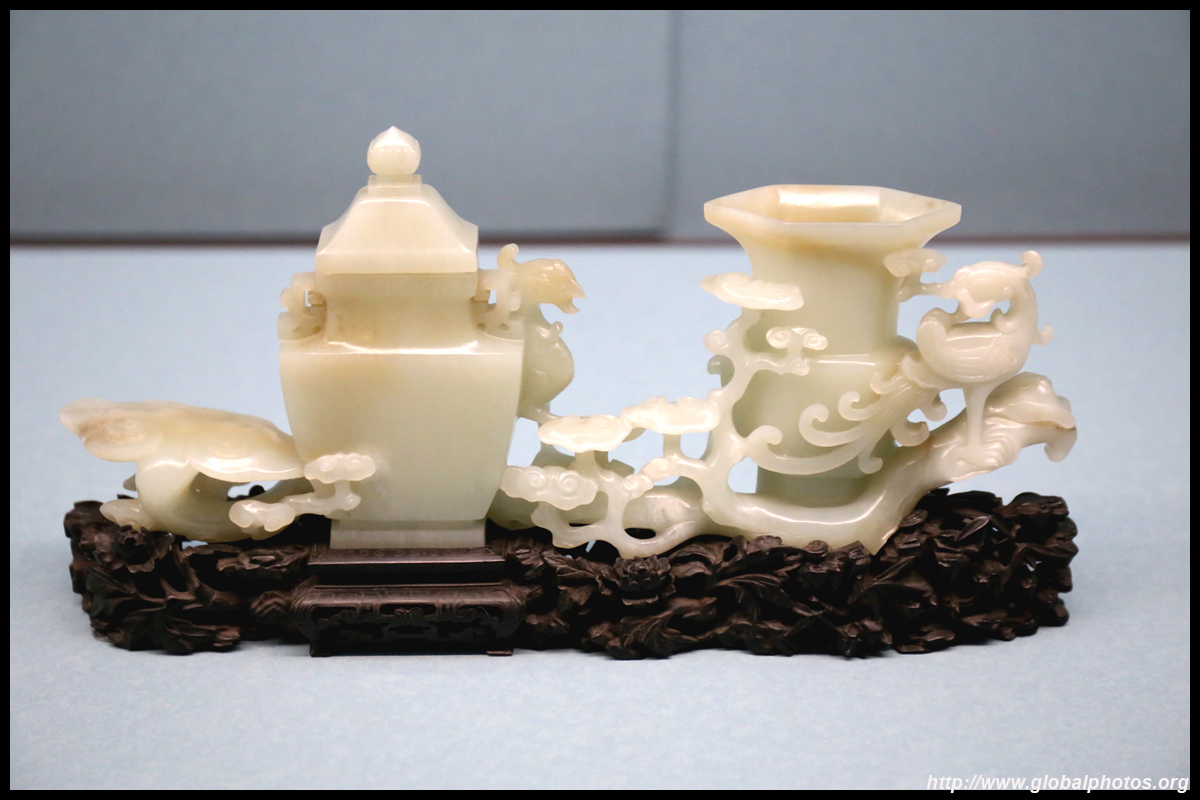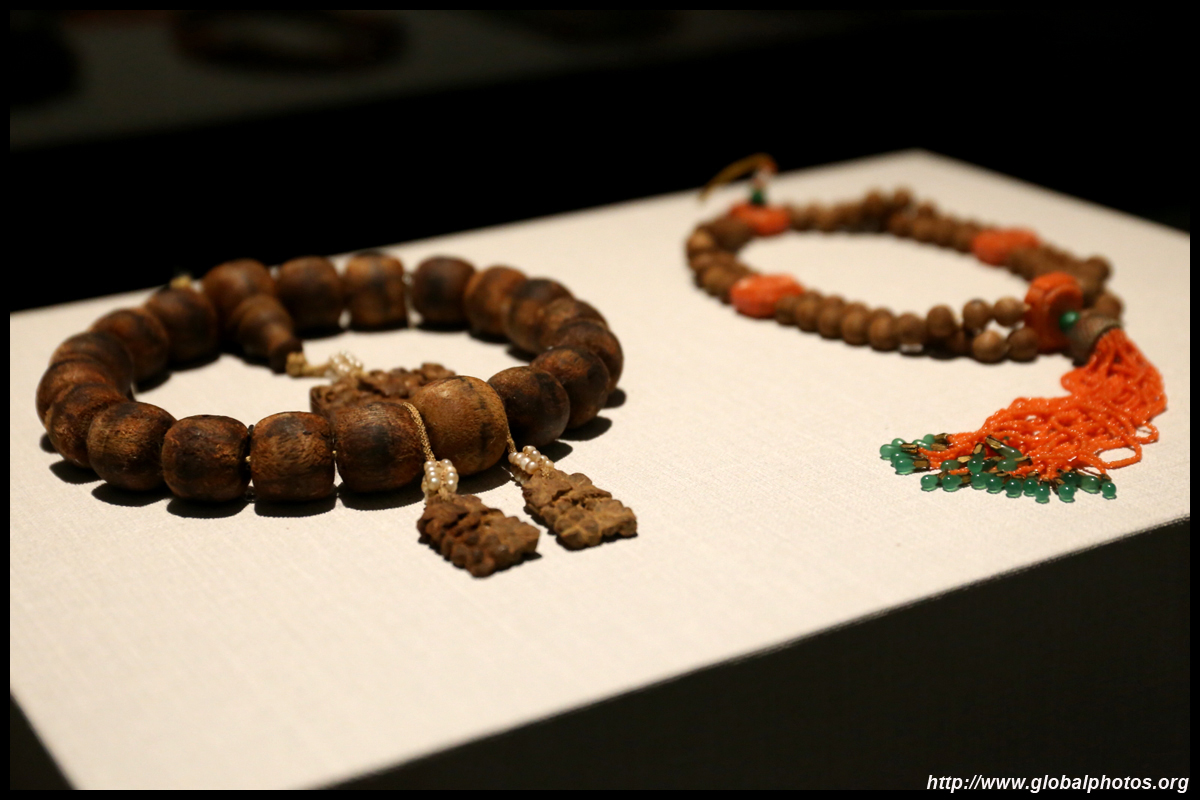Taipei National Palace Museum Photo Gallery
| |||
The last emperor of the Qing Dynasty, Pu Yi, was expelled from the Forbidden City in 1924. After taking stock of the items within the imperial palace, it opened to the public the following year. During the Japanese invasion, the museum collection was moved further west away from the frontlines, but as the Chinese civil war resumed after World War II and the tide turned against the Nationalist government, they decided to bring over 230,000 objects from the Palace Museum with them to Taiwan.Hence, a visit to Beijing's Forbidden City is not complete unless you also visit the National Palace Museum in Taipei. This gold chalice dates from the Qing Dynasty's Qianlong era (1736-95).
This jade tablet dates from Shandong's Longshan culture from about 2000 years before Christ.
This jade ornament is some 4500 years old.
|
|||

|

|

|

|

|

|

|

|

|

|

|

|

|

|

|

|
These Tang Dynasty jade belt plaques show foreigners presenting exotic gifts.
These jade ornaments date from the Yuan Dynasty.
This Yuan or Ming Dynasty jade ornament shows wild ducks in a lotus pond.
|
|||

|

|

|

|

|

|

|

|

|

|

|

|

|

|

|

|
This Jade disc has a dragon and phoenix pattern and is believed to date from the Late Warring States to early Western Han period.
|
|||

|

|

|

|

|

|

|

|

|

|

|

|

|

|

|

|
This jade seal dates from the Qing Dynasty's Qianlong era (1736-95).
|
|||

|

|

|

|

|

|

|

|

|

|

|

|

|

|

|

|
|
|||

|

|

|

|

|

|

|

|

|

|

|

|

|

|

|

|
|
|||

|

|

|

|

|

|

|

|

|

|

|

|

|

|

|

|
|
|||

|

|

|

|

|

|

|

|

|

|

|

|

|

|

|

|
|
|||

|

|

|

|

|

|

|

|

|

|

|

|

|

|

|

|
Early Ming Dynasty porcelains were sourced from the same Jingdezhen and Longquan kilns that served the previous imperial court and also export markets.
|
|||

|

|

|

|

|

|

|

|

|

|

|

|

|

|

|

|
|
|||

|

|

|

|

|

|

|

|

|

|

|

|

|

|

|

|
|
|||

|

|

|

|

|

|

|

|

|

|

|

|

|

|

|

|
|
|||

|

|

|

|

|

|

|

|

|

|

|

|

|

|

|

|
|
|||

|

|

|

|

|

|

|

|

|

|

|

|

|

|

|

|
|
|||

|

|

|

|

|

|

|

|

|

|

|

|

|

|

|

|
|
|||

|

|

|

|

|

|

|

|

|

|

|

|

|

|

|

|
|
|||

|

|

|

|

|

|

|

|

|

|

|

|

|

|

|

|
|
|||

|

|

|

|

|

|

|

|

|

|

|

|

|

|

|

|
This Tang Dynasty handscroll depicts envoys from foreign states with the name of the country above each.
|
|||

|

|

|

|

|

|

|

|

|

|

|

|
|
|||

|

|

|

|

|

|

|

|

|

|

|

|

|

|

|

|
|
|||

|

|

|

|

|

|

|

|

|

|

|

|

|

|

|

|
|
|||

|

|

|

|

|

|

|

|

|

|

|

|

|

|

|

|
|
|||

|

|

|

|

|

|

|

|

|

|

|

|

|

|

|

|
|
|||

|

|

|

|

|

|

|

|

|

|

|
|
It takes about half a day to quickly browse through the collection's highlights. It gets crowded very quickly with tour groups so best to get here as soon as it opens. Getting here is not that straight forward as it is nowhere near an MRT station. The most popular way is to take the R30 bus from Shilin station.To revitalize the ailing tourism economy in southern Taiwan, a branch of this museum opened in Chiayi's outskirts in late 2015. There may be times when the best collection from Taipei is sent south. Combined tickets are available for both museums, although check what's on display in Chiayi before you make the long day trip to visit. I was quite unlucky as the 2 most famous artifacts were in the south on the day of my visit in January 2020. For more photos from the southern branch, click here.
|
|||




































































